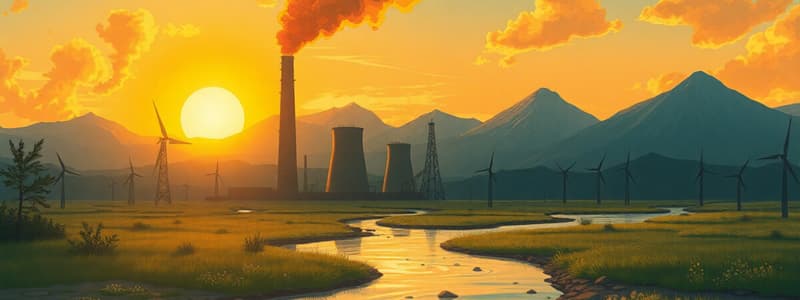Podcast
Questions and Answers
Which of the following is a significant disadvantage of using coal as an energy source?
Which of the following is a significant disadvantage of using coal as an energy source?
- It is a clean and efficient energy source with no environmental impact.
- It requires minimal water for extraction and processing.
- It contributes to habitat destruction through mining and releases greenhouse gases and pollutants during combustion. (correct)
- It produces no greenhouse gas emissions during combustion.
Which of these accurately describes a primary environmental concern associated with natural gas extraction through fracking?
Which of these accurately describes a primary environmental concern associated with natural gas extraction through fracking?
- Fracking requires minimal water usage, conserving water resources.
- Fracking has no environmental impact due to its clean burning process.
- Fracking eliminates the need for land use and habitat disturbance.
- Fracking can lead to groundwater contamination and the release of methane, a potent greenhouse gas. (correct)
What is a notable environmental disadvantage associated with nuclear power despite its lack of greenhouse gas emissions during operation?
What is a notable environmental disadvantage associated with nuclear power despite its lack of greenhouse gas emissions during operation?
- Nuclear power relies heavily on fossil fuels.
- The problem of radioactive waste storage and the potential for accidents. (correct)
- Nuclear power has very high operational costs.
- Nuclear power plants always have disastrous radiation leaks.
Why, according to the information, is hydrogen fuel sometimes considered not truly renewable?
Why, according to the information, is hydrogen fuel sometimes considered not truly renewable?
What is a primary environmental disadvantage of using biomass as a source of energy, especially in the context of subsistence fuel?
What is a primary environmental disadvantage of using biomass as a source of energy, especially in the context of subsistence fuel?
Which environmental issue is most directly associated with the large-scale production of biodiesel from soy or palm?
Which environmental issue is most directly associated with the large-scale production of biodiesel from soy or palm?
What is a key limitation of solar energy as a primary power source, even though it produces no greenhouse gases during use?
What is a key limitation of solar energy as a primary power source, even though it produces no greenhouse gases during use?
What is a significant ecological consequence associated with hydroelectric dams?
What is a significant ecological consequence associated with hydroelectric dams?
Despite geothermal energy having low greenhouse gas emissions, what is a potential environmental concern associated with its use?
Despite geothermal energy having low greenhouse gas emissions, what is a potential environmental concern associated with its use?
What is a recognized negative impact of wind energy, despite being a clean source of power?
What is a recognized negative impact of wind energy, despite being a clean source of power?
Which of the following energy transitions would likely result in the LEAST amount of habitat destruction?
Which of the following energy transitions would likely result in the LEAST amount of habitat destruction?
A community that is heavily reliant on wood for heating and cooking decides to switch to biodiesel. What is a likely negative environmental consequence of this transition?
A community that is heavily reliant on wood for heating and cooking decides to switch to biodiesel. What is a likely negative environmental consequence of this transition?
An isolated island community currently relies on diesel generators for electricity. They are considering switching to hydrogen fuel cells. What factor most critically determines whether this switch significantly reduces their environmental impact?
An isolated island community currently relies on diesel generators for electricity. They are considering switching to hydrogen fuel cells. What factor most critically determines whether this switch significantly reduces their environmental impact?
A town is situated in a valley with consistent wind patterns. The local government wants to invest in a renewable energy source. Considering the town's geography, which of the following factors is MOST important to evaluate when deciding between wind and hydroelectric power?
A town is situated in a valley with consistent wind patterns. The local government wants to invest in a renewable energy source. Considering the town's geography, which of the following factors is MOST important to evaluate when deciding between wind and hydroelectric power?
A region is heavily dependent on coal for electricity generation. To reduce air pollution and greenhouse gas emissions, the government plans to transition to a mix of solar and natural gas. What is one potential trade-off the region might face during this transition?
A region is heavily dependent on coal for electricity generation. To reduce air pollution and greenhouse gas emissions, the government plans to transition to a mix of solar and natural gas. What is one potential trade-off the region might face during this transition?
Flashcards
Nonrenewable Energy
Nonrenewable Energy
Energy sources that cannot be replenished at the rate they are consumed.
Coal
Coal
Combustible sedimentary rock, provides a large amount of energy.
Crude Oil
Crude Oil
A liquid fossil fuel formed from marine organisms.
Natural Gas
Natural Gas
Signup and view all the flashcards
Nuclear Power
Nuclear Power
Signup and view all the flashcards
Hydrogen Fuel Cell
Hydrogen Fuel Cell
Signup and view all the flashcards
Renewable Energy
Renewable Energy
Signup and view all the flashcards
Depletable Renewable Energy
Depletable Renewable Energy
Signup and view all the flashcards
Biomass
Biomass
Signup and view all the flashcards
Biofuels
Biofuels
Signup and view all the flashcards
Biodiesel
Biodiesel
Signup and view all the flashcards
Non-Depletable Energy
Non-Depletable Energy
Signup and view all the flashcards
Solar Energy
Solar Energy
Signup and view all the flashcards
Hydroelectric Energy
Hydroelectric Energy
Signup and view all the flashcards
Geothermal Energy
Geothermal Energy
Signup and view all the flashcards
Study Notes
Energy Sources: Pros and Cons
Nonrenewable Fossil Fuels
Coal
- Mining is relatively easy.
- Types include: lignite, bituminous, and anthracite.
- Cons include: habitat destruction (decreased biodiversity), CO2 and GHG emissions plus pollutants from combustion such as sulfur, mercury, SOx, NOx, and particulate matter (soot and ash), which cause respiratory problems.
Crude Oil
- Has lots of uses via fractional distillation.
- Cons include: CO2 emissions, oil spills, and requirement for lots of water for bitumen extraction.
Natural Gas (Fracking)
- Considered the cleanest fossil fuel.
- Decreased CO2 and pollutant emissions compared to other fossil fuels.
- Cons include: methane (CH4) which is a potent greenhouse gas, large water usage, release of volatile organic compounds (VOCs), and potential contamination of groundwater.
Nuclear Power
- Pros is lots of power and relatively low cost once set up.
- No GHG emissions during power generation.
- Cons include: radioactive waste storage, thermal pollution, high building costs, potential for disasters, and radiation.
Renewable Energy Sources
Hydrogen Fuel Cell
- No GHG emissions.
- H2 + O2 produces H2O and heat.
- H2 can be stored.
- Cons include: nonrenewable source of H2 takes energy (FF) and the resulting product(H2O) is clean.
Depletable Biomass
- Low cost and easy access, especially for subsistence fuel.
- Carbon neutral.
- Cons include: deforestation, CO2 increase, VOC emissions lead to respiratory problems and smog, and air pollutants.
Biofuels
- Ethanol (from corn) or algae can substitute for gasoline.
- Low energy efficiency.
Biodiesel
- Made from soy and palm.
- Monocropping and deforestation can result.
Non Depletable Energy Sources
Solar
- Decreases habitat destruction.
- Energy is stored in batteries.
- No GHG emissions when in use.
- Cons include: only effective if sunny, silicon mining produces CO2 and GHGs, creates waste and toxins, and birds can be harmed.
Hydroelectric
- No air pollution and provides other ecosystem services like recreation.
- Relatively cheap once set.
- Cons include: flooding upstream, decreased sedimentation downstream, and is initially expensive.
Geothermal
- Uses magma heat, which is free.
- No GHG emissions
- Expensive to set up.
- Hydrogen sulfide is released.
Wind
- Clean with potential to share land, which decreases habitat destruction.
- Is not always windy.
- Endangers birds and bats.
Studying That Suits You
Use AI to generate personalized quizzes and flashcards to suit your learning preferences.




